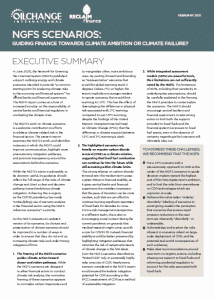In June 2020, the Network For Greening the Financial System (NGFS), a network of central banks and supervisors willing to work on the “greening” of finance, published its first set of climate scenarios. The aim was clear: to help measure and manage financial climate risks. Despite being welcomed by the financial sector and put forward by the British presidency of COP26, these scenarios have dangerous shortcomings. The analysis conducted by Oil Change International and Reclaim Finance shows that they could cause a slowdown in the fight against climate change and an increase in the associated financial risks. The NGFS needs to turn the tide when revising its scenarios.
The NGFS scenarios were eagerly awaited by regulators and central banks, who intend to launch their first climate “stress tests”, as well as by financial players, who are looking for new tools to measure risks and alignment with climate objectives. The British presidency of COP26 proposed to make them models to be followed by the entire financial sector.
The intention of the NGFS is commendable, building a common working base for climate scenarios is particularly useful to ensure that the financial sector is moving in the right direction.
However, its presentation choices and assumptions raise many questions. So much so that the published scenarios could lead to slow down climate action and increase the related financial risks:
- The NGFS sets aside the 1.5°C scenarios and focuses on the 2°C scenarios. It distinguishes two “representative” scenarios that both target 2°C and qualifies all 1.5°C scenarios as “alternative”. These “alternative” scenarios are barely visible in the NGFS report. Therefore, despite IPCC warnings, the difference between a global warming of 1.5 and 2°C is minimized.
- All the scenarios highlighted by the NGFS rely on high levels of carbon capture, technologies that are unlikely to be deployed on a large scale and which raise important sustainability and human rights concerns. Even the scenarios labeled “limited carbon capture (CDR)” imply a level of capture that exceeds the sustainable mitigation potential estimated in current scientific studies.
- The use of CO2 capture and the low level of ambition mentioned above create a bias in favor of fossil fuels. In one of the NGFS reference scenarios, oil and gas production would be respectively 36% and 23% lower than in a “business as usual” scenario and coal would still be burned after 2050. Moreover, this same scenario only induces a 24% decrease in cumulative investment in fossil fuels from 2016 to 2050.
The NGFS must therefore revise its scenarios to position in their center a 1.5°C scenario adopting a precautionary approach on carbon capture. It must be transparent on the assumptions of its scenarios and emphasize the need for central banks and financial regulators to adopt concrete and rapid measures to eliminate their support to the fossil fuel sector.

